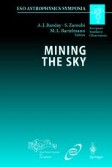Search
Search Results
-
FORCE: FORtran for Cosmic Errors
We review the theory of cosmic errors we have recently developed for count-in-cells statistics. The corresponding FORCE package provides a simple and...
-
Relating Galaxy Cluster X-Ray Luminosities to Gravitational Masses in Wide-Angle Surveys
The cosmologically most important cluster parameter is its gravitational mass. In order to constrain cosmological models of structure formation by...
-
Automated Classification Techniques for Large Spectroscopic Surveys
With the onset of large, systematically selected spectroscopic surveys we have the opportunity to understand the distribution and evolution of...
-
Fast Algorithms and Efficient Statistics: N-Point Correlation Functions
We present here a new algorithm for the fast computation of N-Point correlation functions in large astronomical data sets. The algorithm is based on...
-
Automatic Technique for Spectral Analysis
The paper puts forward two automatic methods to deal with astronomical spectra. An automatic classification method of stellar spectra using the Self...
-
Noise Estimation in CMB Time-Streams and Fast Iterative Map-Making
We describe here an iterative method for jointly estimating the noise power spectrum from a CMB experiment’s time-ordered data, together with the...
-
Source Identification Through Decision Trees
This paper presents the use of decision tree based techniques for optical / ultraviolet source identification. Such techniques allow to improve...
-
Mining the Thermal SZ Effect with a Speedy Pixon Algorithm
A Speedy Pixon Algorithm for image reconstruction is applied. Galaxy clusters are extracted from multi-wavelength microwave sky maps using the...
-
Extracting Knowledge from Very Large Datasets in a Multi-Wavelength Context
The ability to extract knowledge from very large data catalogues resulting from sky surveys or from deep wide fields, observed at various wavelength...
-
Splitting the Sky - HTM and HEALPix
Mission data sets are increasing in size and complexity. To enable efficient processing and storage of such data sets a tessellation scheme may be...
-
Case Study of Handling Scientific Queries on Very Large Datasets: The SDSS Science Archive
The SDSS Science Archive (SX) was designed to enable scientific data mining and interactive data exploration on the terabyte scale. It consists of a...
-
The Deepest Field
The Cosmic Microwave Background (CMB) anisotropy experiments are starting to map the last scattering surface at...
-
On the Evolution of Nearby Star-Forming Systems and Their Connection to Primeval Galaxies
We present the state of the art of a project to infer the spectro-photometric and chemical evolution history of some benchmark nearby star-forming...
-
Constraining Models of Galaxy Formation with Deep Multicolor Galaxy Surveys
We present a comparison between the observed properties of high redshift galaxies, as they result from the analysis of deep multicolor imaging...
-
ISO Observations of Star-Forming Galaxies
The Infrared Space Observatory (ISO) is used to carry out mid-IR (7 and $15...
-
Distant Disk Galaxies: Kinematics and Evolution to $z \sim 1$
High resolution HST images have been combined with Keck+LRIS and VLT+ISAAC spectra to study the internal kinematics of 100 faint disk galaxies in the...
-
The Star Formation Density in the High-Redshift Universe
We use images of the Hubble Deep Fields (HDFs) to estimate the universal star formation density (SFD) and its evolution. We find that it increases...
-
A Deep Look at the Most Distant X-Ray Clusters
We present highlights from a study of galaxy populations and the intracluster medium (ICM) in three galaxy clusters at z > 1.2, the most distant...
-
Population of Cl1601+42 at z = 0.54
We use photometric redshifts to determine the rest frame cluster luminosity function (LF) to...
-
Deep Observations of Lyman Break Galaxies
We summarise the main results of recent work on the Lyman break galaxy population which takes advantage of newly commissioned instrumentation on the...
